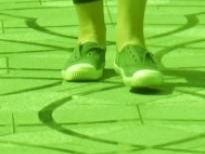Rochelle

(Text only clips) Rochelle developed a bald patch on her temple when she was aged 14. She saw a dermatologist once but did not find it helpful. The prescribed medications didn’t work for her and she has since been trying different products bought from hair shops.
Rochelle is 23 years old. She is in a long term relationship and lives at home with her parents. Her ethnicity is Black Caribbean.
More about me...
Rochelle first developed a bald patch on the temple area of her head when she was 14 years old. Over the years, the hair on her temple has repeatedly fallen out and then regrown, and her alopecia has not affected any other parts of her scalp or body. She finds it reassuring that the hair tends to regrow and she is keen to find products which will permanently help. Her GP referred her to a dermatologist but Rochelle did not find the appointments helpful. Looking back on it, she is annoyed at how she was treated by medical professionals but felt too preoccupied with wanting to get her hair back at the time. Rochelle began researching different products and visiting hair shops to see what they stocked. She describes it as a process of “trial and error”: some products have been really effective but others sting and do not seem to help. She spends a considerable amount of time and energy trying to find products to stop her hair loss. She also has mild eczema, which she has had since she was a baby, and she copes well with managing it now. One shop-bought product she tried for her alopecia was originally meant for eczema, but she has since stopped using it after finding out that it contained steroids.
Rochelle was at secondary school when she first had a bald patch. She says that this is a difficult time when young people often feel very insecure. She thinks it helped that she attended an all-girls school because a mixed sex school might have meant more pressure on appearances. Rochelle’s hair loss was very gradual. Family and friends reassured her at first that they couldn’t see any difference to her hairline. She was very shocked when she first felt the bare skin of her scalp where hair had previously been. From this point onwards, everything became a “rush” with seeing her GP and then a dermatologist. She was distraught and cried a lot. She tried to disguise the bald patch with hair bands, later moving on to wearing weaves and partial wigs with a front fringe.
Rochelle’s GP referred her to a dermatologist. She remembers the dermatologist telling her that her hair may never grow back and that it would fall out completely if she permed it. The dermatologist said that the hair loss was because of stress but Rochelle does not believe this. She thinks her hair had been pulled too tightly in canerows (which can cause traction alopecia), but also says that weaves helped her hair grow back at another time. Rochelle’s dermatologist gave her several prescribed medications which she used for two months. These didn’t seem to work so she phoned the dermatology clinic. She was told to stop using them and she was not offered a follow-up appointment. At this point, Rochelle felt that she had to take the matter into her own hands through online research and trying out different shop-bought products. She thinks healthcare professionals should recognise that alopecia matters because hair can be a big part of personal identity.
Rochelle has been interested in hair generally for a long time, even before she developed alopecia. She says that hair is very important to many women in the black community. She likes talking to people about hair and she also finds it helpful to look online for blogs and Youtube videos. Rochelle does a lot of internet-based research about haircare products and wigs, although she prefers to go to a shop to buy something so that she can see and smell it. She has found that some of the products she uses leave a medical smell, so she has a routine of using these ones before bed and masking it with oils in the morning. She tries a shop-bought product for two weeks; if it doesn’t seem to help in that time, she moves on to the next one. Rochelle also changes the hair products to suit different seasons; for example, she uses almond oil in the summer because it is lighter than castor oil. She usually mixes the oil with shea butter, a sealant which she also uses on her skin to manage her eczema, so that it is more likely to absorb into the hair.
Rochelle’s family, boyfriend and close friends have been hugely supportive and offered her lots of reassurance over the years. She values the advice from other people about things to try for her alopecia, including from the other customers and the owners she meets in the hair shops. Rochelle thinks that healthcare professionals should think more about emotional support for young people with alopecia, although she thinks that the opportunity to meet other young people with alopecia would have been more beneficial for her when she was diagnosed than one-to-one counselling. Rochelle has since looked up local alopecia support groups but she is hesitant about going to a meeting. She is unsure how she would cope with meeting people with more severe alopecia than her own and worries that she “would feel a bit out of my depth”. Rochelle says that she is not interested in prescription medications for alopecia as long as she can wear a weave to disguise the bald patch. She prefers using natural products and hopes that changing aspects of her lifestyle and diet will help maintain the regrowth of her hair in the future.


